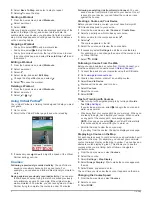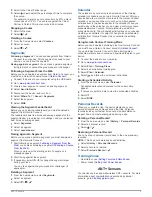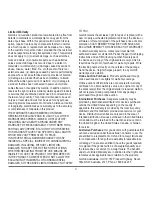
Courses, workouts, and training plans
: Activities previously
selected from Garmin Connect are sent wirelessly to your
device.
Software updates
: Your device wirelessly downloads the latest
software update. The next time you turn on the device, you
can follow the on-screen instructions to update the software.
Setting Up Wi
‑
Fi Connectivity
1
Go to
www.garminconnect.com/start
, and download the
Garmin Express™ application.
2
Follow the on-screen instructions to set up Wi
‑
Fi connectivity
with Garmin Express.
Connecting to a Wireless Network
1
Select >
Wi-Fi
.
2
If necessary, select
Wi-Fi
to turn on wireless technology.
3
Select
Add Network
to scan for available networks.
4
Select a wireless network.
5
If necessary, select to enter the network SSID and
password.
The device stores the network information and connects
automatically when you return to this location.
Data Recording
The device uses smart recording. It records key points where
you change direction, speed, or heart rate.
When a power meter is paired, the device records points every
second. Recording points every second provides an extremely
detailed track, and uses more of the available memory.
For information about data averaging for cadence and power,
see
Data Averaging for Cadence or Power
.
Changing the Data Storage Location
1
From the home screen, select >
System
>
Data
Recording
>
Record To
.
2
Select an option:
• Select
Internal Storage
to save your data to the device
memory.
• Select
Memory Card
to save your data to an optional
memory card.
Installing a Memory Card
You can install a microSD™ memory card for additional storage
or pre-loaded maps.
1
Pull up the weather cap
À
from the microSD card slot
Á
.
2
Press in the card until it clicks.
Data Management
NOTE:
The device is not compatible with Windows® 95, 98,
Me, Windows NT®, and Mac® OS 10.3 and earlier.
Connecting the Device to Your Computer
NOTICE
To prevent corrosion, thoroughly dry the USB port, the weather
cap, and the surrounding area before charging or connecting to
a computer.
1
Pull up the weather cap from the USB port.
2
Plug the small end of the USB cable into the USB port on the
device.
3
Plug the large end of the USB cable into a computer USB
port.
Your device and memory card (optional) appear as
removable drives in My Computer on Windows computers
and as mounted volumes on Mac computers.
Transferring Files to Your Device
1
Connect the device to your computer.
On Windows computers, the device appears as a removable
drive or a portable device, and the memory card may appear
as a second removable drive. On Mac computers, the device
and memory card appear as mounted volumes.
NOTE:
Some computers with multiple network drives may
not display device drives properly. See your operating
system documentation to learn how to map the drive.
2
On your computer, open the file browser.
3
Select a file.
4
Select
Edit
>
Copy
.
5
Open the portable device, drive, or volume for the device or
memory card.
6
Browse to a folder.
7
Select
Edit
>
Paste
.
The file appears in the list of files in the device memory or on
the memory card.
Deleting Files
NOTICE
If you do not know the purpose of a file, do not delete it. Your
device memory contains important system files that should not
be deleted.
1
Open the
Garmin
drive or volume.
2
If necessary, open a folder or volume.
3
Select a file.
4
Press the
Delete
key on your keyboard.
Disconnecting the USB Cable
If your device is connected to your computer as a removable
drive or volume, you must safely disconnect your device from
your computer to avoid data loss. If your device is connected to
your Windows computer as a portable device, it is not
necessary to safely disconnect.
1
Complete an action:
• For Windows computers, select the
Safely Remove
Hardware
icon in the system tray, and select your device.
• For Mac computers, drag the volume icon to the trash.
2
Disconnect the cable from your computer.
Navigation
Navigation features and settings also apply to navigating
courses (
Courses
) and segments (
Segments
).
• Locations and finding places (
Locations
)
• Planning a route (
Planning and Riding a Route
)
• Route settings (
Route Settings
)
• Optional maps (
Purchasing Additional Maps
)
• Map settings (
Map Settings
)
Locations
You can record and store locations in the device.
Saving Your Location
You can save your present location, such as your home or
parking spot.
Navigation
9






























